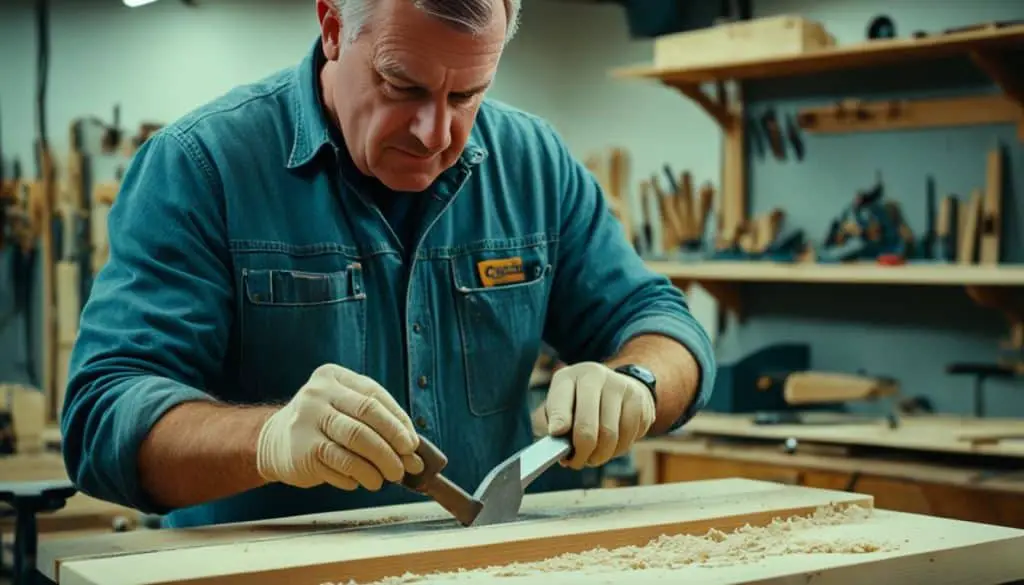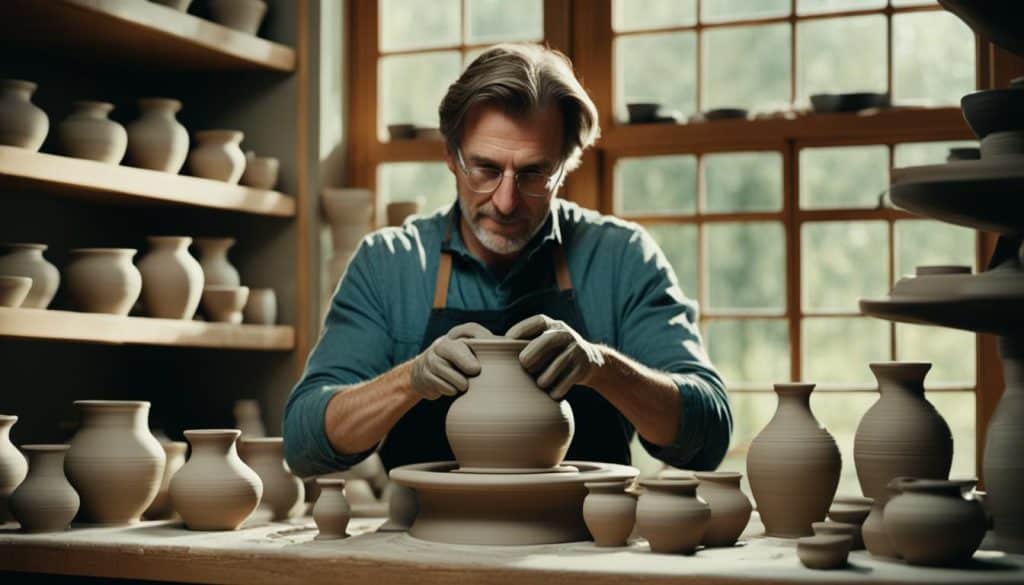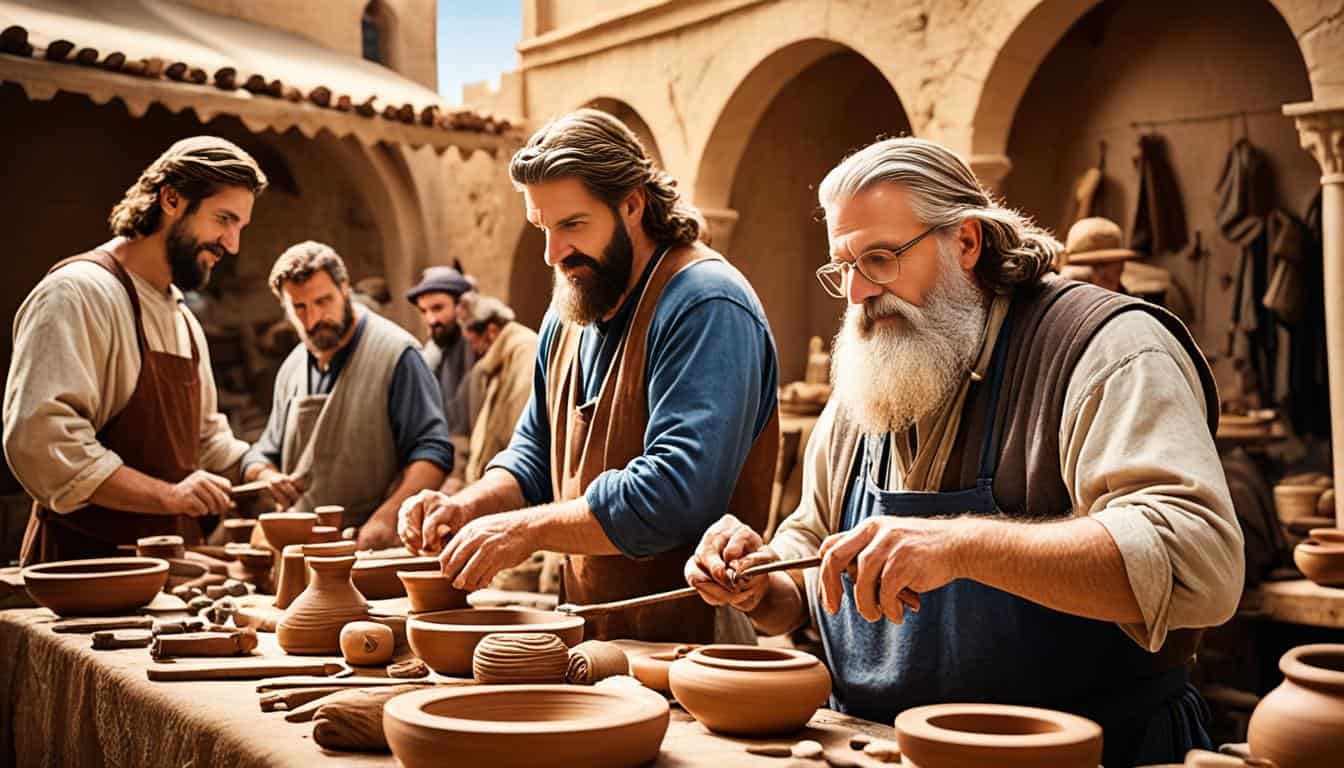Table of Contents
Ever wondered about the skilled folks behind the crafts in the Bible? Metalworkers built the tabernacle and weavers made the high priest’s clothes. These artisans were vital in keeping cultural and religious traditions alive.
So, who were these artisans? What did they do and how did they shape the world of craftsmanship?
Let’s dive into the incredible world of artisans from biblical times. We’ll look at the eight kinds of skilled workers who made history. Follow along as we reveal the hidden tales of their work and its importance.
Metalworkers (Exodus 31:4-5)
In the Bible, we read about Bezalel and Oholiab, invited by God to work on the tabernacle. They were given special skills and filled with the spirit of God. This included wisdom, understanding, and craftsmanship beyond comparison.
Exodus 31:4-5 tells us they could do amazing work with metals, stones, and wood. They were able to make beautiful art in every way possible.
“Bezalel and Oholiab were not just ordinary metalworkers, but they were imbued with the spirit of God, possessing exceptional wisdom, knowledge, and skill in craftsmanship.”
These two metalworkers put their hearts into creating special pieces. They were building the tabernacle, a place of worship, and it needed perfection. Bezalel and Oholiab showed incredible skill and care.
| Materials | Skills | Designs |
|---|---|---|
| Gold | Mastering metalworking techniques | Intricate patterns and motifs |
| Silver | Precise metal manipulation | Elegant adornments |
| Bronze | Crafting durable and strong structures | Ornate fixtures and fittings |
Bezalel and Oholiab made the tabernacle a divine place as was intended. It became a sacred spot for the Israelites.
Preserving a Legacy of Craftsmanship
These metalworkers showed true mastery and understanding of their craft. They helped keep the Israelite culture alive.
Their story is a model for any creative person. It shows what can be done with talent, hard work, and God’s guidance.
Weavers (Exodus 28:39)
Weavers were very important in ancient times. They made beautiful clothes, like the ephod for the high priest. This garment was described in Exodus 28:39.
“You shall weave the coat in checkered work of fine linen, and you shall make a turban of fine linen, and you shall make a sash embroidered with needlework.”
In Exodus 28:6, we learn that the ephod was crafted from various colors. These included gold, blue, purple, scarlet yarns, and linen. Weavers combined these to make a stunning garment.
The ephod wasn’t just beautiful. It had a deep symbolic meaning too. It had two pieces that sat on the high priest’s shoulders. These pieces were joined by special clasps and had gems for each of the twelve tribes of Israel.
It was more than a garment. It was a symbol of unity between the high priest and the people. Weavers were not only skilled but understood the religious importance of their work. They knew how to convey deep meanings through their craft.
Image: Altar of burnt offering along with the priestly garments

Symbolism of Colors
Colors in the ephod held special meaning for the Israelites’ values and traditions.
| Color | Symbolic Meaning |
|---|---|
| Blue | Represented the divine presence and authority |
| Purple | Signified royalty and wealth |
| Scarlet | Symbolized sacrifice, blood, and sin |
| Fine Twisted Linen | Emphasized purity and righteousness |
Using these colors, weavers showed great skill and an understanding of deep symbolism. Their craft made the ephod both beautiful and meaningful.
Studying the weavers’ work helps us understand the past better. It shows how art, faith, and culture were interconnected in ancient times.
Stoneworkers (1 Kings 7:13-14)
In building the grand temple, Solomon got help from skilled stoneworkers. One of them was Hiram, a talented craftsman from Tyre. Hiram was key in making Solomon’s dream a reality.
1 Kings 7:13-14 tells us how special Hiram was. He didn’t just work with stone. Hiram showed his skill with gold, bronze, iron, and timber too. His detailed and beautiful designs made the temple shine.
“And King Solomon sent and brought Hiram from Tyre. He was the son of a widow from the tribe of Naphtali, and his father was a man of Tyre, a worker in bronze; and he was full of wisdom and understanding and skill for doing any work in bronze. So he came to King Solomon and performed all his work.”
Hiram and Solomon working together created a true masterpiece. The temple was filled with magnificent pillars and detailed carvings. Each part of the temple showed the hard work and talent of these stoneworkers.
Materials Used by Stoneworkers
Stoneworkers used gold, bronze, iron, stone, and timber in their work. They combined these materials skillfully. This blend made the temple grand, durable, and beautiful.
| Materials | Applications |
|---|---|
| Gold | Decorative elements, intricate motifs |
| Bronze | Pillars, vessels, utensils |
| Iron | Structural components, tools |
| Stone | Foundations, walls, steps |
| Timber | Roofing, supports, furnishings |
Carpenters and Builders (1 Chronicles 14:1)
David saw the need for skilled craftsmen after taking Jerusalem. These workers in stone and wood rebuilt the city. They were key to its growth and development.
They had a special talent for creating strong structures from basic materials. Their work included buildings and walls, vital for Jerusalem.
David trusted these artisans to make the city’s homes and fortifications. By doing so, he aimed to boost his people’s quality of life.
These skilled workers focused on every detail, like how pieces fit together and the beauty they added. They ensured the buildings stood strong and looked good.
Wood was a main material for them. They made beams, doors, and art with it. Their work highlighted wood’s natural beauty and strength.
Stone was also crucial, providing stability and long life. Carpenters and builders used stone well. They created structures that lasted a long time.
David’s Vision for Jerusalem
“For David said, ‘God has broken through my enemies by my hand like a breakthrough of water.’ Therefore they called the name of that place Baal Perazim.” (1 Chronicles 14:11)
This verse highlights David’s fierce goal to make Jerusalem great. Carpenters and builders were a big part of his plan. They showed God’s favor through their work.

The Legacy of Carpentry and Building
While ancient craftsmen used different tools, their dedication was just as strong. Their work lives on in ancient structures today.
The beauty of their carved beams and solid stone brings admiration even now. Their creativity and skill continue to impress everyone.
Materials Used by Carpenters and Builders
| Materials | Usage |
|---|---|
| Wood | Construction of beams, columns, doors, and decorative elements. |
| Stone | Incorporated into foundations, walls, and other architectural features to provide durability and strength. |
| Tools | Various carpentry and building tools such as saws, chisels, hammers, and levels. |
Potters (Jeremiah 18:1-6)
In Jeremiah, the potter’s wheel shows God’s rule over us. Pottery is made by potters with great care, much like God’s crafting of life.
Jeremiah 18:1-6 tells how God sent Jeremiah to a potter. At the potter’s place, Jeremiah saw clay being shaped. Just as the potter shapes the clay, God shapes our lives.
God tells Jeremiah, “O house of Israel, can I not do with you as this potter does? Behold, like the clay in the potter’s hand, so are you in My hand.” (Jeremiah 18:6)
Using the potter’s wheel, the Bible shows God’s power in our lives. It highlights how God, like a potter, directs our paths for a special purpose.
God’s work in us is like a potter on a wheel. The potter’s wheel points to God’s ability to form and change us. He turns us into purposeful, beautiful beings just as potters make essential pottery or art.
Potters are vital for art and function in pottery. Their talent adds beauty and usefulness to the world. This shows how important creativity is to human culture.
The potter’s wheel symbolizes a balance. It shows how we have choice but are under God’s guidance. Our free will and God’s direction work together, much like clay and the potter.
The potter’s wheel story also teaches us about trusting God’s plan. It highlights that, with care, God shapes our lives for a good purpose. He works lovingly to fulfill His plan in us.
God’s Sovereignty and Our Journey
The potter’s wheel analogy invites us to trust in God’s complete control over our lives. We are like clay, being carefully shaped by God for meaningful purposes.
Just as a potter molds clay, God shapes our lives. He refines us through life’s ups and downs. God prepares us to serve Him in unique and important ways.
Thinking about the potter and clay, we see God’s constant work in us. He uses every experience to make us vessels of His grace and love.
Therefore, let’s fully trust in God’s hand. He is lovingly crafting our lives for His glory.

Musicians (1 Chronicles 25)
During biblical times, music was key in worship to express faith. King David set up musical guilds detailed in 1 Chronicles 25, gathering talented musicians skilled in different instruments and vocals.
David chose skilled harpists, singers, and cymbal players for the temple. They led in praise and thanks, setting a spiritual tone. These musicians were skilled and devoted.
Harpists made beautiful music with their harps. Singers led songs, uplifting everyone. Cymbal players added to the music’s rhythm and energy.
The role of music in worship was huge then. 1 Chronicles 25 musicians enhanced the spiritual aspect, helping connect people to God. Their work was highly respected, and they were central to the worship and culture of that period.

Music and Worship
“Sing to him a new song; play skillfully, and shout for joy.” – Psalm 33:3
Music is a vital part of worship and expressing spirituality. In the past, musicians were key in leading worshippers, using their talents to glorify God.
These musicians’ traditions carry on today, enriching religious ceremonies and personal faith practices. Like them, we can use music to enhance our spiritual experiences.
Music has an incredible power to inspire and connect us with the divine. Sing, play, or listen – music offers a path to profound spiritual experiences. Let’s honor the musicians of old for their lasting influence on how we connect with spirituality through music.
Leatherworkers (Judges 17:1-5)
In the past, leatherworkers showed off their talent making clothes and items. This is seen in the story of Micah in Judges 17:1-5. It talks about a person skilled in making clothes, which likely means they were a leatherworker.
Leatherworking was a complex art. It included cutting, stitching, and shaping animal hides. This made sturdy and useful items. Those who worked with leather were key in making clothes and goods from this tough material.
Leatherworkers were highly valued for their ability to transform animal hides into garments that not only served as practical attire but also symbolized social status and personal style.
They were especially important for making protective gear like coats and boots. They also made accessories like belts and bags. These not only shielded people but also showed who they were.
Leatherworkers used hides from cattle, sheep, and goats. They made beautiful and practical clothes with tanning, dying, and embossing. This turned plain hides into eye-catching clothes everyone wanted to wear.
Looking at Judges 17:1-5, we see how important these craftspeople were. Micah made an idol from silver and dedicated it to the Lord. The link between the garment maker and idols sheds light on the cultural and religious role of crafters back then.
To sum up, leatherworkers from the Bible were not just skilled but vital in their communities. They turned animal hides into clothes and accessories. Their work met practical and personal needs, showing their importance.
| Artisan | Verse | Relevant keywords |
|---|---|---|
| Leatherworkers | Judges 17:1-5 | leatherworkers, Judges 17:1-5, Micah, idol, garment maker |
Scribes (Exodus 31:18)
Scribes weren’t called artisans, but what they did was key. They helped keep knowledge and religious texts safe in ancient times. They wrote down God’s words with skill.
These folks were experts. Scribes spent their lives carefully copying and saving info. They made sure that the teachings and texts lasted for years to come.
The Importance of Scribes
“Exodus 31:18” says Moses wrote the Ten Commandments. This shows how important writing was. Scribes copied down divine messages so people later could read and learn.
Writing down important knowledge was hard back then. Scribes used special items like quills and natural ink. They took great care and made sure every word was right when copying sacred texts.
The Expertise of Scribes
Writing was so important that the Ten Commandments were “written with the finger of God” (_Exodus 31:18_). Scribes had the job of copying these holy words correctly.
But scribes did more than copy religious texts. They also worked on legal papers, histories, and cultural stories. Their skill and accuracy helped keep ancient knowledge alive.
The Legacy of Scribes
Because of scribes, we can still read important texts today. They worked hard to save knowledge. Without them, much of this information might have been lost.

Conclusion
The artisans in biblical times were very talented. They made important things for the culture and religion. For example, people like Bezalel and Oholiab made beautiful things from metals. They used gold, silver, and bronze. Weavers also made special clothes, especially for the high priest.
Hiram, a stoneworker, showed his skills well. He worked with stone and wood. These artisans built and repaired many structures. One famous building was the temple in Jerusalem.
There were also musicians and people who worked with leather and clay. They expressed their beliefs through their work. Scribes were very important, too. They kept the written parts of their culture safe.
This group did more than make things. They shared their culture and beliefs with each other. They also kept stories and knowledge alive for the future. Their work shows how creative and clever people can be. It reminds us of the power of human skill and effort.




